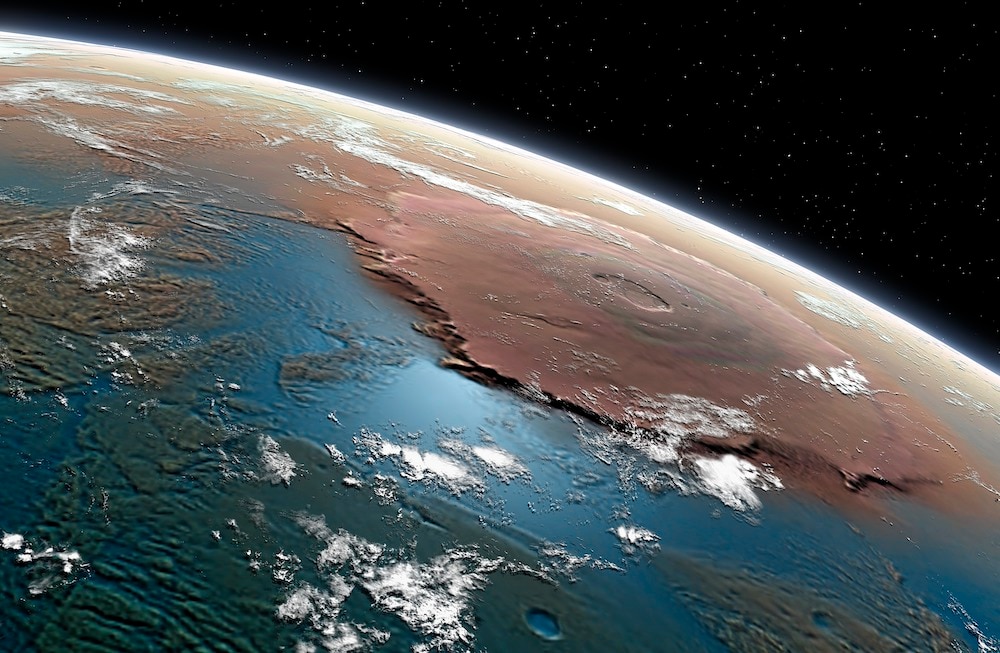Create a free profile to get unlimited access to exclusive videos, sweepstakes, and more!
Was Mars still freezing, just wetter, 3 billion years ago?
This is what the Martian weather forecast might have looked like 3 billion years ago.

As Perseverance keeps creeping across Jezero Crater (which was proven to have been a bona fide lake billions of years ago), questions on the habitability Mars are still floating in space.
Martian life-forms may have never existed, and if they did, what conditions would they have had to face? Some think what now appears to be a red and dead planet was once a lush Earthlike realm with surface water and temperatures that would have been ideal for life as we know it to flourish. Now there is another, much drearier vision of what Mars might have been. It could have had a cold, wet climate just high enough to keep a possible ocean from freezing over.
Think of those raw winter days when everything is slush and ice. Other hypotheses considered a warm and wet or cold and dry Mars, but never cold and wet. This one went there. Researchers Frédéric Schmidt of Université Paris-Saclay and Michael Way of NASA Goddard, along with an international team of scientists, coauthored a study, recently published in The Astrophysical Journal, on what the Martian weather forecast might have looked like 3 billion years ago.
“Our study is the first to find a temperate region with an ocean while the mean global surface temperature remains below freezing,” Schmidt and Way told SYFY WIRE. “We found a limited valley network due to rainfall near the shoreline and large glaciers from the highlands and shoreline.”
ROCKE-3D, a 3D global climate model based off of the ModelE software used for Earth forecasts, predicted what the weather would have been like on the Red Planet billions of years ago. It was adjusted to the conditions ancient Mars is thought to have had, from gravity and gas composition to the distance and strength of brightness from the Sun. The advantage Mars had back then, before the Sun blasted most of its atmosphere into space, was molecular hydrogen (H2), which was needed for a greenhouse effect. Its absence would have meant a frozen planet.
Mars would have had to have 10% H2 in its atmosphere for the climate to remain cold and slushy. That would keep the temperature below 32 degrees Fahrenheit, which explains water freezing into glaciers, but such a vast body of water as the ocean that is believed to have been in its Northern Hemisphere would have kept a consistent temperature of nearly 45 degrees Fahrenheit. With that percentage of H2, it would have also rained over the ocean and some of the nearby land at low elevations. There also had to be some heat to keep the ocean liquid.
“Atmosphere and ocean are a machine to transport solar heat from the equator to the pole. We found that the ocean circulation is responsible for significant heat flux toward the Martian north pole,” said Way and Schmidt. “We found that this heat could warm up the polar ocean.”
Solar heat could have raised ocean temperatures by up to about 40 degrees Fahrenheit. Considering that the ocean must have been close to 45 degrees, that could bring it to a maximum of 85 degrees, which sounds more like a tropical reef than a planet on which you’d need a winter coat. Sunlight would hit the equator and build up heat in that region. Warm water from the equator would then be transported north. That may or may not mean alien microbes. There could have been a chance for life — whether it was life as we know it or not.
Say Mars hosted life as we know it. Some life-forms thrive in the most extreme places here on Earth, even in glaciers and the oceans around them. Tardigrades can be frozen into a state of suspended animation until temperatures become decent enough for them to unfreeze and do whatever tardigrades do. There are also bizarre worms that squirm around in glaciers most of the year, mysteriously emerging only in the summer and then retreating back inside. A Martian ocean would have been a water source (obviously) and protected anything alive from radiation.
“At the time, life was expanding in more and more ecosystems on the Earth, so having similar conditions on Mars is optimistic,” the researchers said. “From our understanding, a stable ocean is a necessary condition for life, as it appeared on the Earth, but this is still not sufficient.”
If Perseverance comes up dry with its rock samples, maybe a future spacecraft can go digging through the ice of the Martian north pole to see if there are any frozen microbes.


























